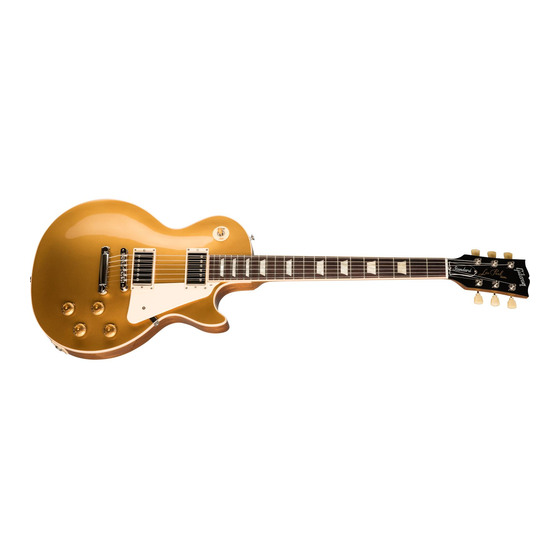Table of Contents
Advertisement
Quick Links
Advertisement
Table of Contents

Subscribe to Our Youtube Channel
Summary of Contents for Gibson ES-335 Dot Fat Neck
- Page 1 HOW TO BUY AN ELECTRIC GUITAR. Common sense rules to an informed purchase.
- Page 2 © 2008 Gibson Guitar Corp.
- Page 3 The 15 easy rules you’ll find in the following pages were formulated from interviews with professional players and Gibson luthiers who are recognized authorities on guitarmaking. We covered the subjects of playability and dependability with players, and materials and manufacturing with the luthiers.
-
Page 4: Table Of Contents
THE BASICS RULE 1 Pay for Quality RULE 2 Verify Warranty and Service RULE 3 Research the Manufacturer RULE 4 Consider Appreciation MATERIALS ARE IMPORTANT RULE 5 Demand Good Tone Wood RULE 6 Insist on Quiet Electronics MANUFACTURING IS AN ART RULE 7 Balance Craftsmanship with Production RULE 8... - Page 5 RULE 10 Pay Attention to Details RULE 11 Look for Innovation HANDS-ON EXAMINATION RULE 12 Check the Neck RULE 13 Test for Sustain RULE 14 Listen for Electronic Noise RULE 15 Inspect the Finish OWNER ADJUSTMENTS The Truss Rod The Bridge THE LAST NOTE...
- Page 6 Tailpiece Bridge Toggle Switch Button Binding Body Neck Fingerboard Fret Headstock THE COMPONENTS OF THE SOLIDBODY ELECTRIC GUITAR Featuring a 2008 Les Paul Std Volume / Pickups Single Fret Truss Rod Machine Tuning Tone Controls Cutaway Marker / Inlay Cover...
- Page 7 Tailpiece Bridge Body Binding Neck Fingerboard Fret Headstock F-holes Heads THE COMPONENTS OF THE SEMI-HOLLOWBODY ELECTRIC GUITAR Featuring a Gibson ES-335 Three-way Volume / Pickguard Pickups Double Fret Truss Rod Tuning Toggle Switch Tone Controls Cutaway Marker / Inlay Cover...
-
Page 8: The Basics
A lifetime warranty on a new guitar is not extraordinary or unusual. Many of the first electric guitars made by Gibson in the 1930s are still going strong and have long... -
Page 9: Rule 3 Research The Manufacturer
RULE 4 CONSIDER APPRECIATION I think you could buy any of Gibson’s classic models and in a few years, if you wanted to trade it in, get your money out of it. You can’t do that with many things. -
Page 10: Materials Are Important
Les Paul Custom and ES-355. Even an inexpensive but well-made guitar such as Gibson’s Les Paul Junior is worth over ten times more than the original buyer paid for it in the 1950s. - Page 11 For guitar bodies, mahogany and maple are the most common, although ash, alder, korina and various exotic woods are also popular. Different- type electric guitars require different woods and construction methods. Hollowbody archtops, like the...
-
Page 12: Rule 6 Insist On Quiet Electronics
The body of a Gibson ES-335 is a good example; it’s a three-ply laminate with the grain of the middle section running perpendicular to the outer sections for added strength. -
Page 13: Manufacturing Is An Art
And they should be encapsulated in wax or epoxy to prevent microphonic feedback. The quietest pickups are humbuckers, invented at Gibson by Seth Lover in the 1950s. Humbuckers are double-coil pickups, wired so that they cancel out extraneous noise. They were named because they literally “buck... -
Page 14: Rule 8 Evaluate The Neck Joint
Minor adjustments, to accommodate changes in string gauge or in climate, can be accomplished with an adjustable truss rod – a Gibson invention – or an adjustable bridge. (See Owner Adjustments at the end.) -
Page 15: Rule 9 Check Appointments For Functionality
Adjustable features, such as the truss rod or the bridge, should be easily adjustable and not require any degree of disassembly. Traditional designs, such as Gibson’s Tune-o-matic bridge, represent more than tradition. They are still widely used because they have stood the test of time. -
Page 16: Rule 11 Look For Innovation
The answer can be found in the maker’s track record for innovation. A long history of innovations – such as Gibson’s arched top design, adjustable truss rod and humbucking pickup – indicates that a manufacturer is constantly trying to improve its guitars. - Page 17 – an indication of bad quality control and a real cause for concern. Once the guitar is tuned, it should play in tune anywhere on the neck. This is called intonation, and there’s a simple test for it, even if the guitar is not in perfect tune.
-
Page 18: Rule 13 Test For Sustain
Effects boxes are made for a reason. Nobody wants to be surprised by weird sounds coming out of a guitar. Plug into an amp, and move the guitar or bass close to it. That will bring out hum, buzz and shrieking... -
Page 19: Rule
The truss rod maintains neck alignment against the approximately 100 pounds of force exerted by a set of electric guitar strings on the neck. The optimum shape of the neck is not perfectly straight; rather, it should have a slight bow or curvature. -
Page 20: The Bridge
An adjustable truss rod can correct any changes in neck curvature. On a Gibson, the truss rod is adjusted by turning a nut that is found under a bell-shaped celluloid piece on the headstock. A neck with too little... -
Page 21: The Last Note
THE LAST NOTE Gibson invented the f-hole archtop guitar and the semi-hollowbody electric guitar, and Gibson’s solidbody electrics are familiar icons around the world. When it comes to tradition, quality and innovation, ONLY A GIBSON IS GOOD ENOUGH. - Page 22 Gibson Guitar Corp. 309 Plus Park Boulevard Nashville, Tennessee 37217 USA 1-800-4GIBSON www.gibson.com...
















Need help?
Do you have a question about the ES-335 Dot Fat Neck and is the answer not in the manual?
Questions and answers